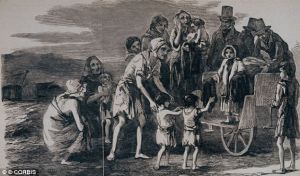I spent some time exploring Boston over Fall Break and came across this set of memorial sculptures while walking the Freedom Trail. I felt especially awful viewing them, as in some sort of gross irony they sit directly across from a Chipotle (and a cupcake shop!!!) so I was so full I could hardly stand when I saw them for the first time. Before last Wednesday’s class, I never really knew much about the Irish Potato Famine, so I when I saw the memorial out of the corner of my eye, I thought it was perfect timing for me to discover it.
We looked at the photo below in class. The little girl, clearly unaffected by starvation, is passing out clothing when what the recipients clearly need is food. This sentiment was echoed in the placards accompanying the figures in Boston. They said, in essence, that the people of Boston would’ve gladly sent supplies to the starving people of Ireland, but they didn’t want the starving people of Ireland coming to Boston. It was upsetting because the Irish who did flee to Boston used the very last of their resources only to be met with prejudice and more starvation. According to the placards, children from the Irish districts of Boston were “literally born to die.”
This sentiment of “I’d love to help them, but only if they don’t come here” is still something that we see. I remember when Hurricane Katrina hit New Orleans in August 2004, and so many people from my native Houston were quick to send aid. But as soon as FEMA started busing survivors to Texas, people freaked out and vocally protested it. They would rather send aid to an invisible problem, something happening miles away and out of sight, rather than help people in front of them.
I don’t have too many scholarly points about the famine, or these figures, other then I feel privileged to be learning about the tragedy in an area so closely linked to the events. I also feel like the prominent placement of the memorial on the Freedom Trail, and admission of nineteenth century Boston’s part in the death of even more Irishmen, serves as a very public apology.



Being from Boston, I’ve walked past this memorial a few times but I’ve never stopped to look at what is was for or read the placards, but I’m glad I know now! Their placement really is ironic.
By: Sam Stone on October 23, 2014
at 8:17 pm
Emily, I have never seen this memorial in person, so I haven’t read the placards. You do a great job of exploring many of its interesting dimensions, and I also think that as a public memorial, it provides a thought-provoking challenge to the narratives of emigration that dominate Irish-American communities in New England. Thanks for posting this.
By: amartinmhc on October 26, 2014
at 5:28 pm